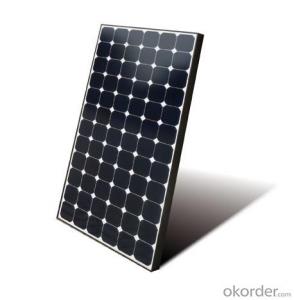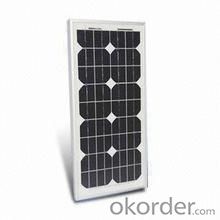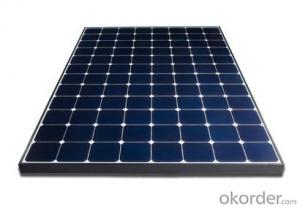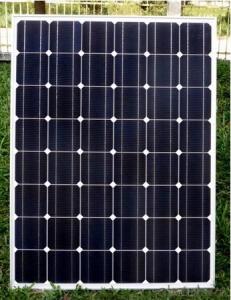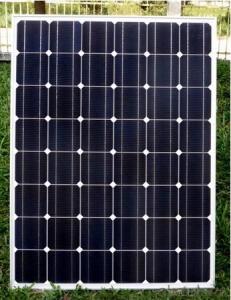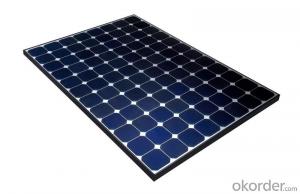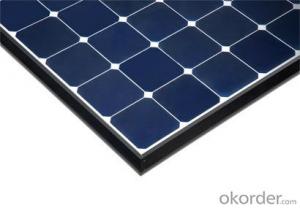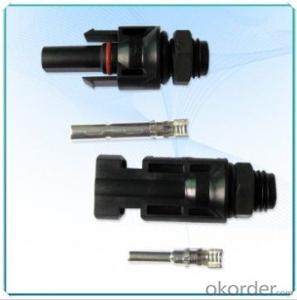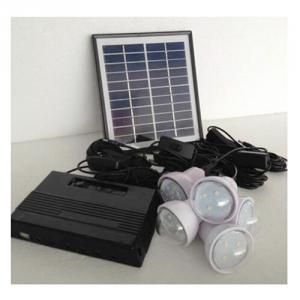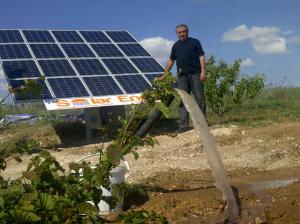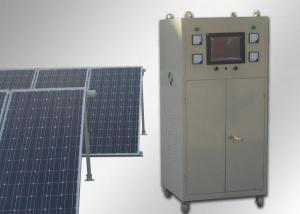Building Integrated Solar Energy Systems - CNBM On Grid System 5000W with Certificate UL, TUV, CE
- Loading Port:
- Shanghai
- Payment Terms:
- TT OR LC
- Min Order Qty:
- 100 watt
- Supply Capability:
- 1000 watt/month
OKorder Service Pledge
OKorder Financial Service
You Might Also Like
Specification
CNBM On Grid System 5000W with Certificate UL TUV CE
Product description
They range from small residential and commercial rooftop systems to large utility-scale solar power stations. Unlike stand-alone power systems, a grid-connected system rarely includes an integrated battery solution, as they are still very expensive. When conditions are right, the grid-connected PV system supplies the excess power, beyond consumption by the connected load, to the utility grid.
Connection of the photovoltaic power system can be done only through an interconnection agreement between the consumer and the utility company. The agreement details the various safety standards to be followed during the connection.[4]
Systems such as Net Metering and Feed-in Tariff which are offered by some system operators, can offset a customers electricity usage costs. In some locations though, grid technologies cannot cope with distributed generation feeding into the grid, so the export of surplus electricity is not possible and that surplus is earthed.
Grid-connected PV systems are comparatively easier to install as they do not require a battery system.[1][6]
Grid interconnection of photovoltaic (PV) power generation systems has the advantage of effective utilization of generated power because there are no storage losses involved.[7]
Grid-connected PV can cause issues with voltage regulation. The traditional grid operates under the assumption of one-way, or radial, flow. But electricity injected into the grid increases voltage, and can drive levels outside the acceptable bandwidth of ±5%.[8]
Grid-connected PV can compromise power quality. PV’s intermittent nature means rapid changes in voltage. This not only wears out voltage regulators due to frequent adjusting, but also can result in voltage flicker.[9]
Connecting to the grid poses many protection-related challenges. In addition to islanding, as mentioned above, too high levels of grid-connected PV result in problems like relay desensitization, nuisance tripping, interference with automatic reclosers, and ferroresonance.[10]
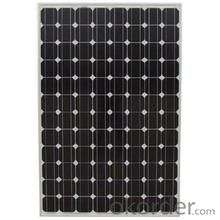
Application
Industrial
Commercial
Residential
Feature
Residential, grid-connected rooftop systems which have a capacity more than 10 kilowatts can meet the load of most consumers.[2] They can feed excess power to the grid where it is consumed by other users. The feedback is done through a meter to monitor power transferred. Photovoltaic wattage may be less than average consumption, in which case the consumer will continue to purchase grid energy, but a lesser amount than previously. If photovoltaic wattage substantially exceeds average consumption, the energy produced by the panels will be much in excess of the demand. In this case, the excess power can yield revenue by selling it to the grid. Depending on their agreement with their local grid energy company, the consumer only needs to pay the cost of electricity consumed less the value of electricity generated. This will be a negative number if more electricity is generated than consumed.[3] Additionally, in some cases, cash incentives are paid from the grid operator to the consumer.
Packaging
With carton and box
- Q: Can solar energy systems be used for water heating in swimming pools or hot tubs?
- Yes, solar energy systems can be used for water heating in swimming pools or hot tubs. Solar thermal collectors capture the sun's energy and transfer it to the water, providing an efficient and cost-effective way to heat the water in pools and hot tubs. These systems can significantly reduce energy consumption and operating costs, making them a popular choice for environmentally friendly and sustainable water heating.
- Q: Can a solar energy system be used in areas with high humidity?
- Yes, a solar energy system can be used in areas with high humidity. While it is true that high humidity can affect the performance of a solar energy system to some extent, modern solar panels are designed to withstand various weather conditions, including high humidity. The efficiency of solar panels may decrease slightly in high humidity due to the moisture in the air, but it is not a significant factor that would render solar energy systems ineffective. Additionally, proper maintenance and cleaning of the panels can help mitigate any potential issues caused by humidity. Overall, solar energy systems can still be effectively utilized in areas with high humidity.
- Q: Can solar energy systems be used in powering greenhouses or nurseries?
- Yes, solar energy systems can be effectively used in powering greenhouses or nurseries. The abundant sunlight available in these environments makes solar power an ideal and sustainable energy source. Solar panels can be installed on the rooftops or nearby areas to harness solar energy, which can then be used to power various greenhouse operations such as lighting, heating, and irrigation systems. This reduces reliance on traditional energy sources and helps create a more eco-friendly and cost-effective solution for powering these agricultural facilities.
- Q: Can a solar energy system be installed on a military base or facility?
- Yes, a solar energy system can be installed on a military base or facility. In fact, many military bases around the world have already implemented solar energy systems as a sustainable and reliable source of power. Installing solar panels on military bases not only helps reduce their dependence on traditional energy sources but also enhances their energy security and resilience. Solar energy systems can be easily integrated into existing infrastructure on military bases, including rooftops, parking lots, or open fields. They can provide electricity for various purposes, such as powering buildings, lighting, heating, and cooling systems, as well as charging electric vehicles. In addition to reducing carbon emissions and combating climate change, solar energy systems also contribute to cost savings for military bases in the long run by reducing energy bills and increasing energy efficiency. Moreover, solar energy systems on military bases offer several strategic advantages. They enhance energy independence, reducing reliance on vulnerable foreign energy sources and minimizing the risk of supply disruptions. By generating electricity locally, military bases become less susceptible to blackouts or power outages caused by natural disasters, cyber-attacks, or enemy actions. This increased energy resilience ensures that critical operations can continue even in challenging circumstances. Furthermore, solar energy systems align with the military's commitment to environmental sustainability and reducing its carbon footprint. By setting an example and demonstrating leadership in renewable energy deployment, military bases can inspire and influence other sectors to adopt clean energy technologies, thereby contributing to national and global efforts to combat climate change. In conclusion, solar energy systems are highly suitable for installation on military bases and facilities. They provide a reliable, sustainable, and cost-effective source of power while enhancing energy security and resilience. By embracing solar energy, military bases can achieve their strategic objectives, reduce their environmental impact, and inspire others to follow suit.
- Q: What is the impact of temperature on the efficiency of a solar energy system?
- The temperature greatly affects the efficiency of a solar energy system. As the temperature rises, the efficiency of solar panels decreases. This is because of how the semiconductor materials used in solar cells behave. When solar panels are exposed to sunlight, they absorb photons and convert them into electricity. However, as the temperature increases, the resistance of the semiconductor material also increases, which leads to a decrease in the flow of current. This phenomenon is called the temperature coefficient of power. The temperature coefficient of power is usually expressed as a percentage per degree Celsius and varies depending on the type of solar panel technology. Most solar panels have a negative temperature coefficient, meaning their efficiency decreases as the temperature rises. On average, solar panel efficiency can decrease by around 0.5% to 0.8% for every degree Celsius increase in temperature. Moreover, increased temperatures can cause thermal losses within the system. The heat can accumulate in the solar panels, further reducing their efficiency. This is particularly true in hot climates or when there is high solar irradiance. To address the impact of temperature on solar energy system efficiency, various strategies can be employed. One common approach is to incorporate cooling mechanisms, such as ventilation or water circulation, to dissipate the excess heat generated by the solar panels. This helps maintain lower operating temperatures and consequently improves overall efficiency. Furthermore, proper system design and installation techniques can also reduce temperature-related losses. For instance, mounting solar panels with sufficient spacing to allow for air circulation can prevent overheating. Additionally, choosing solar panels with lower temperature coefficients can help minimize efficiency losses in high-temperature environments. In conclusion, temperature significantly affects the efficiency of a solar energy system. Higher temperatures can cause a decrease in solar panel efficiency, mainly due to increased resistance in the semiconductor materials. To optimize the performance of solar energy systems, strategies like cooling mechanisms and proper system design should be implemented.
- Q: Are there any fire safety concerns associated with solar energy systems?
- Yes, there are fire safety concerns associated with solar energy systems. While solar energy systems are generally considered safe and reliable, there have been instances where these systems have caused fires. One potential fire safety concern is related to faulty installation or maintenance of the solar panels. If the panels are not properly installed, there is a risk of electrical faults or short circuits, which can lead to overheating and potentially cause a fire. Similarly, if the system is not regularly inspected and maintained, it can increase the risk of electrical failures and subsequent fires. Another concern is related to the electrical wiring and connections of the solar energy system. Faulty wiring or loose connections can generate heat and may result in electrical fires. This is particularly relevant in older systems where wiring may have deteriorated over time. Moreover, during a fire incident, firefighters may face additional challenges when dealing with buildings equipped with solar energy systems. The presence of live electricity generated by the panels can pose a risk to firefighters, making it more difficult to safely extinguish the fire. To mitigate these fire safety concerns, it is crucial to ensure that solar energy systems are installed by qualified professionals following the necessary codes and regulations. Regular inspections and maintenance should also be conducted to identify and address any potential issues promptly. Additionally, it is important for firefighters to receive proper training on how to handle fires involving solar energy systems to minimize risks.
- Q: Can solar energy systems be used for powering electric vehicle charging pads?
- Certainly, solar energy systems have the capability to power electric vehicle charging pads. Sunlight can be harnessed and transformed into electricity through the installation of solar panels on rooftops or open areas. Consequently, this generated electricity can be utilized to operate the charging pads for electric vehicles. By incorporating solar energy, we not only diminish our reliance on fossil fuels but also mitigate the discharge of greenhouse gases associated with charging electric vehicles using grid electricity. Moreover, solar-powered charging pads can be implemented in remote or off-grid areas where access to the power grid is restricted or nonexistent. This renders solar energy systems an environmentally sustainable and favorable solution for energizing electric vehicle charging pads.
- Q: What is the role of microinverters in a solar energy system?
- Microinverters play a crucial role in a solar energy system as they convert the direct current (DC) produced by individual solar panels into alternating current (AC) that can be used to power homes and businesses. Unlike traditional string inverters, microinverters are installed on each panel, allowing for better energy production and system performance, even in shaded or partially shaded areas. Additionally, microinverters enable real-time monitoring of each panel's performance, simplifying maintenance and troubleshooting processes.
- Q: Can solar energy systems be installed in areas with heavy snowfall?
- Solar energy systems can indeed be installed in areas that experience heavy snowfall. However, it is crucial to consider the snow's effect on system performance and take necessary precautions during installation. Snow can temporarily decrease the amount of sunlight reaching the solar panels, thus reducing energy production. Nevertheless, the panels are designed with a tilt and smooth surface, enabling snow to easily slide off. Furthermore, technological advancements have resulted in the creation of snow-resistant solar panels that are highly efficient at converting sunlight into electricity even in snowy conditions. It is also worth mentioning that solar panels are often angled for optimal exposure to the sun, thereby minimizing snow buildup. Ultimately, while heavy snowfall may impact the efficiency of solar energy systems, they can still be effectively installed and contribute to renewable energy generation in areas with such weather conditions.
- Q: Can solar energy systems be used in apartment buildings or multi-unit dwellings?
- Yes, solar energy systems can be used in apartment buildings or multi-unit dwellings. These systems can be installed on the roof or in common areas to generate clean and renewable energy for the entire building or shared spaces. This allows residents in apartment buildings to benefit from reduced energy costs and a more sustainable living environment.
Send your message to us
Building Integrated Solar Energy Systems - CNBM On Grid System 5000W with Certificate UL, TUV, CE
- Loading Port:
- Shanghai
- Payment Terms:
- TT OR LC
- Min Order Qty:
- 100 watt
- Supply Capability:
- 1000 watt/month
OKorder Service Pledge
OKorder Financial Service
Similar products
Hot products
Hot Searches
Related keywords
